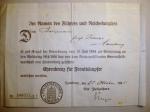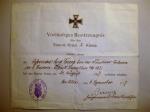-
Posts
5,629 -
Joined
-
Last visited
Content Type
Profiles
Forums
Blogs
Gallery
Events
Store
Everything posted by IrishGunner
-

EK 1914 EK2 document
IrishGunner replied to IrishGunner's topic in Germany: All Eras: The Iron Cross
Chris, not a checklist exactly - since I haven't found a definitive list of "all" artillery units (Chip...scan scan scan and share ) But I have a couple pretty good lists of units. I keep track on a spreadsheet all the units that I have collected - by feld, fuss, bavarian, non-regimental battalions and batteries etc. Even a few Austrian units. Scorecard is in my profile as of January. In February I have added a few more; so, step by step. Actually, have a unit or two that haven't shown up on my lists. Which means I am making a new list. Good mix of items too; commemorative medals, award documents, militaerpass, regimental history first edition books, postcards, CDV photos, death cards, other ephemera (an ID card). I have decided at some point I need to score key items; pickelhaube, sabre, luger. Need to save some money. Would like to get some shoulder straps; maybe even a tunic. So, much to collect! So little time, so little money! :cheeky: -

EK 1914 EK2 document
IrishGunner replied to IrishGunner's topic in Germany: All Eras: The Iron Cross
Uwe, thanks for the assist. I also thought "Tramp" - but thought that too odd for a German name. -

EK 1914 EK2 document
IrishGunner replied to IrishGunner's topic in Germany: All Eras: The Iron Cross
-
These arrived in the mail this week; haven't done any research yet. Found it interesting that a Fahrer in a Sachsen fuss-artillerie battalion ended up as a Kaufmann in Hamburg. There's a story there that will never be found. I could use a little help with the name though... Looks like "Ernst Framp" to me... And no idea what is in parentheses after "Fahrer". (Again, apologize for the quality of images. )
-

EK 1914 Slime and the EK...
IrishGunner replied to Chris Boonzaier's topic in Germany: All Eras: The Iron Cross
On a serious note though; considering this librarian received a combatant EK... Given your research, how common was that? I suspect fairly common. And given the number of EK's just handed to officers - just for being officers... Maybe the EK isn't a particularly worthy decoration after all. :unsure: -

EK 1914 Slime and the EK...
IrishGunner replied to Chris Boonzaier's topic in Germany: All Eras: The Iron Cross
So, that means ... I guess ... that you have been wrong TWICE in this blue moon then. :cheers: -

EK 1914 Slime and the EK...
IrishGunner replied to Chris Boonzaier's topic in Germany: All Eras: The Iron Cross
Are you drinking something a bit too strong tonight? :cheeky: -

EK 1914 Slime and the EK...
IrishGunner replied to Chris Boonzaier's topic in Germany: All Eras: The Iron Cross
Occasionally? :rolleyes: -
Les, thanks for the link. As I mentioned in the original post, I already did an internet search and came up with very general information like this wiki article. Unfortunately, the internet sources lack specific details on the employment of air ships. The implication from the wiki articles like the one you link is that air ships were used almost exclusively for bombing, but it doesn't give a good idea of the unit types associated with powered air ships (presumably used for bombing) and the units with tethered balloons (presumably used for observation).
-

At Last! Brodie Mia!
IrishGunner replied to Chris Boonzaier's topic in Great Britain: Militaria: Badges, Uniforms & Equipment
Nice chapeau ("Brodie Mia!"? I suppose you will wear this in the garden while singing ABBA songs. ) -
I couldn't find much on the internet regarding the composition and mission of the Luftschiffer-Abteilungen. Were these units used for bombing missions or as observers (for artillery?) or both? The specific unit that raised this question in my mind is Feldluftschiffer-Abteilung Nr. 8 Any information would be appreciated as I know nothing about air ships.
-

Serbia Decoration/Plaque - Drvar
IrishGunner replied to wlodzimierz's topic in Southern European & Balkan States
Interesting history and award... Hvala vam! :cheers: -

EK 1914 "The" Award?
IrishGunner replied to Chris Boonzaier's topic in Germany: All Eras: The Iron Cross
How does this factor with the Pour le Merite? Do we see that being worn as the only other glitter with the EK's? Seems like at least for aviators, that was the coin of the realm. -

EK 1914 "The" Award?
IrishGunner replied to Chris Boonzaier's topic in Germany: All Eras: The Iron Cross
Exactly why Hitler wore his... :whistle: -

Schiessliste - I.Btl./Fußartillerie-Regiment 10
IrishGunner replied to The Prussian's topic in The Great War 1914 to 1918
Andreas sent me this in an email before he went to bed... ------------------------------------------------------------------------------ Quote Andreas: That are one of my problems too. Stellungs-Ziel and Artillerie-Ziel. If we look at the times , we see x+85-x+174 at the Stellungs-Ziel and x+175-x+189 at Artillerie-Ziel. Maybe these are targets, whose should be shot directly? The amunitions. Splitter means splinter (I think), like a shrapnell. I think the different colours seemed to be gas grenades. The 15cm s.F.H. could shoot "Grünkreuz", "Blaukreuz" and "Gelbkreuz" There were 1 green cross (3,9l Diphosgen) 1 green cross varaiation (3,9l Diphosgen, Brommethylethylketon) 1 green cross varaiation (3,9l Brommethylethylketon) 1 green cross varaiation (3,9l Phenylcarbylaminchlorid) 1 green cross (Grünkeuz 1): 30-70% Diphosgen, 70-30% Chlorpikrin 2 green crosses (Grünkreuz 2, Grünkreuz-Brisanz): 3,2l 60% Phosgen, 28% Diphosgen, 12% Diphenylarsinchlorid, 0,187kg TNT 1 blue cross (Blaukreuz-Brisanz) 1,35kg Diphenylarsinchlorid in 3,47kg TNT 1 or 2 blue crosses (Blaukreuz 1) Diphenylarsinchlorid mixed with Phenylarsinchlorid) -

Schiessliste - I.Btl./Fußartillerie-Regiment 10
IrishGunner replied to The Prussian's topic in The Great War 1914 to 1918
Andreas and I have exchanged a couple emails to sort out the Schießtafel in Post #3; thought I would share with the crowd in case anyone is interested. Below is what is I know about this fire plan based upon translation and an understanding of artillery fire. The first number on the left - “9” - is the duration in minutes to shoot at this particular target. The second column reflects “x bis x+9” - “x” being the start of the fire plan and “x+9” being 9 minutes after the start of the fire plan. The data to the left is to be fired for the first 9 minutes of the fire plan. In this case, it looks like the commander simply wrote a “9” to the left to help better see the duration of fire for his battery at this target. “Klarzeit” is the time the fire plan begins and then goes in set intervals of "x+minutes". This looks like the fire plan began at 0110 hours; this is “x”. The next set of numbers - “2845” - is range to the target. This would then be converted to the elevation for the gun to adjust; this would come from a published firing table specific to the gun. Since this Schießtafel applies to various calibers of guns, this figure does not appear. (Actually, 2845 meters doesn't seem all that far for heavy artillery to be away from the target. Of course, the max effective range for the 15cm schwere Feld Haubitze - the gun that this table is likely for - was 8600 meters.) Artillery fire is effected by weather conditions; a shell flying through the air can be put off course or land short or beyond the target due to weather. So, range is adjusted for Wittungseinfluss (W.E.). I read in the order that the Wetterdienst sends this out by Fernspruch daily; in this case, it doesn't look like the weather had any effect since the range did not change. (Probably was not raining or foggy.) There is also a remark for “Erhoeung in Grad” - this would be the elevation of the target; however, they didn't make a remark for this; so, the target area was most likely not a hill. The commander did make a note for “Glw.” - “Gelaendewinkel” - this is a factor that in English we call “site”. This is a factor that considers that the target is at a different elevation than the location of the guns (even though they didn't make a note of the target's elevation.) This is the "-3" and would be applied to the elevation set on the gun. The “+120” is the direction of fire in degrees. This would be the azimuth of fire set on the gun. (Surprising they used degrees instead of mils.) The “Wie oft 1 Schuss” tells how often each type of gun listed should fire one round. The blue number to the right under the “Mun.” column is “8” or “9” - this looks like the total number of rounds to be fired for this target. That means this table was prepared for the s.F.H. (schwere Feld Haubitze) because the s.F.H. Should fire one shell every 1 minute 10 seconds. In 9 minutes they should be only able to shoot 7.7 shells; it looks like they rounded up to “8”. I cannot read the hand-writing to figure out why “9”. This continues for the other targets at the other “x+ times”. Do you see in the 90 minutes fire time, the commander crossed out the round per minute factor for the s.F.H. Making a new time for each shell. This also suggests this was made for the 15cm s.F.H. Only things that I do not quite understand are: "Stellungsziel" and "Artl.Ziel" on the left side. In the computations these are very different ranges. Maybe the Stellungsziel is shooting at the positions in the trenches since it is a shorter range (2845). And the Artl. Ziel is counter-battery fire against the enemies artillery - at a greater range (6300). I also do not know the difference of the "blau" gruen" and "splitter" munitions; types of shells, but how they are different, I do not know. -

Schiessliste - I.Btl./Fußartillerie-Regiment 10
IrishGunner replied to The Prussian's topic in The Great War 1914 to 1918
Sicher, Ich kann deutsch. My email can be linked from my profile... -

Schiessliste - I.Btl./Fußartillerie-Regiment 10
IrishGunner replied to The Prussian's topic in The Great War 1914 to 1918
Well, if it isn't a thousand pages, könnte ich vielleicht mit der Übersetzung helfen. And as an artilleryman, I might be able to decipher some of the abbreviations. Just a thought... :whistle: -

Schiessliste - I.Btl./Fußartillerie-Regiment 10
IrishGunner replied to The Prussian's topic in The Great War 1914 to 1918
You should write an article using these plans... ;)




